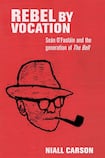
Writing about his years as a Harkness fellow in Harvard, Seán O’Faoláin recalled fantasies of academic life in Ireland: “After three years at Harvard and with its PhD under my belt, I could see myself swishing into the quadrangle of UCC in a low-slung, high-powered car, with a beard just like Stockley’s.”
WFP Stockley was O’Faoláin’s professor at University College Cork, a man whose mind he memorably compared to “a lady’s sewing basket after a kitten had been through it”. Though Stockley was hardly an intellectual influence, O’Faoláin admired his lifestyle in the “Lilliput” world of 1920s UCC. The young scholar was saved from “the soft smother of the provincial featherbed” when the National University awarded the Cork chair of modern English to O’Faoláin’s old mentor, Daniel Corkery.
The two men have come to represent opposing versions of 20th-century Ireland: Corkery with his stern republican politics and narrow views on national culture and Ó Faoláin the cosmopolitan who opposed State censorship and looked to Europe and the US.
Despite these differences, both writers shared deep roots in the Cork experience of the fight for Irish freedom. O’Faoláin met the older Corkery via the Gaelic League in Cork and they shared political as well as cultural convictions. O’Faoláin became “a rank-and-filer” in the IRA, helped to make bombs for the anti-Treaty side in the Civil War and went on to take various roles in IRA publicity. In later life, O’Faoláin wrote that the “very name” of his former mentor made him “squirm”.
As Niall Carson shows in Rebel By Vocation, to understand O'Faoláin is to acknowledge both his rootedness in the world of republican politics and his later, troubled repudiation of early attachments. It is also to catch a particular tone: self-dramatising but lightly ironical, self-absorbed but always self-aware.
Lost childhood
In 1941 O’Faoláin wrote of finding himself “in the lap of the lost mother” on the Aran Islands: “I know that not for years and years did I get free of this heavenly bond of an ancient, lyrical, permanent, continuous, immemorial self, symbolised by the lonely mountains, the virginal lakes, the traditional language, the simple, certain, uncomplex modes of life, that world of the lost childhood of my race where I, too, became for a while eternally young.”
Equally, he could write amusingly of sending his own mother to Cork’s drapers of in search of clothing suitable for Harvard. He had consulted an etiquette book and “sent her off after visiting cards, dress shirts with American-style collars attached, a special and hither-to unheard-of kind of expanding cuff-link, patent-leather pumps, silk under-trunks, riding gloves with cord-woven backs, white woolen socks for squash, Ascot-type cravats for wearing with my dressing gown at breakfast. She was both shocked and enchanted by my needs. I did not dare to inquire after an opera hat, collapsible.”
These contradictions of tradition and modernity coalesce in the Bell. The journal, which ran from 1941 until 1954, was meant to sound an alarm that would awaken consciences dulled by the consensus of the new State. As Julia O'Faolain wrote, her father, finding himself in "internal exile in war-sealed Ireland, hoped to rouse his post-revolutionary readers to think again". As he wrote to fellow Cork man and early friend Frank O'Connor: "We set out to be a natural sort of sane, and quiet, and constructive paper such as any normal country should produce." Despite the effort to avoid "controversy, dramatics, fight, explosions", he and O'Connor later fell out because of the Bell.
The Bell did not leave fight and revolution behind. The first issue was filled with contributors who were "active in the IRA or in republican politics". Arguing that "the old IRA networks offered an efficient source of nourishment", Carson depicts a journal characterised above all by mixed motives and uncertain alliances. In uncovering its history via a focus on O'Faoláin and his fellow writers, Carson makes an original contribution to our understanding of Irish culture between the 1930s and the 1960s.
Carson asks “how O’Faoláin could come to see himself as ideally suited to lead a new generation of Irish writing from the self-proclaimed wilderness to literary salvation”.
He expands our understanding of the Bell by filling in the picture of the "morass of contradictory voices" who gave the journal its distinctive identity; by locating its endeavours within "the Atlantic world of letters"; and by examining its sociological impulses. Carson gives due weight to the role of Peadar O'Donnell, who founded it with O'Faoláin, served as its effective manager and became editor in 1946. The book makes excellent use of archival research, including fascinating material quoted from O'Faoláin's dealings with the BBC.
Carson's scrupulous dissection of the Bell and its milieu can leave the reader wishing for the bigger picture. The idea of "the generation of the Bell" is under-specified. Intriguing figures move in and out of Carson's study, but their stories can feel fragmented. It would be fascinating to know more of Róisín Walsh, the republican feminist and librarian who travelled to the US and USSR and was a member of the Bell's editorial board. Famous figures do not always fare better: Carson sounds uneasy about Elizabeth Bowen, who "professed herself Irish, but reported on Ireland to a belligerent power".
Despite his central role in the history of Ireland's best-known 20th century journal, O'Faoláin does not mention the Bell in the chapter of Vive Moi! that covers 1940-6. "An unrealised chapter? Sadly, yes," writes Julia O'Faolain in her posthumous edition of Vive Moi!. As with his observations on the IRA – "I have no war memories to record" – there is more to say.
With the Bell, O'Faoláin began what Carson calls "the slow boil of creative criticism" in Irish culture. The simmer of dissent did not fade with the passing of the Bell but became submerged within other forms and media. Carson suggests it may be the Late Late Show, rather than any new literary endeavour, that inherits these energies.
Yet the desire for a more critical culture does not itself escape analysis: Carson shows how the forms of imaginative dissent expressed by the Bell were distrusted by the generation after O'Faoláin. With Rebel By Vocation, we have a fresh opportunity to assess the present state of Irish criticism by reference to its past.
Claire Connolly is professor of modern English at University College Cork and author of A Cultural History of the Irish Novel, 1790-1829









